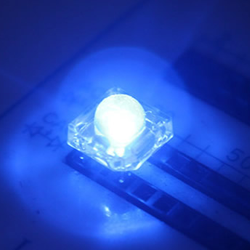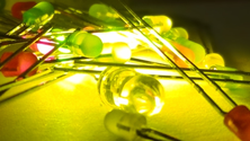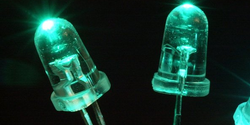Our research has the potential to save millions of lives, save energy, save carbon emissions and enable totally secure communications. It is based on gallium nitride, which is probably the most important new semiconductor since silicon. Unlike silicon, gallium nitride emits brilliant light when a small electric current is passed through it. We can produce light of any colour (for example blue, green, yellow, red) by adding more and more indium to gallium nitride. On the other hand, if we add aluminium to gallium nitride we can produce ultra-violet light. Gallium nitride based light emitting diodes (LEDs) and laser diodes are already in widespread use, for example as LED traffic lights and as Blu-ray laser diodes for the latest DVD players. If we coat a blue LED with a yellow-emitting phosphor then a cool white light is produced, and such white LEDs are used as front bicycle lights, flashlights, backlighting for mobile phones, etc. The aim of this Platform Grant is to underpin our research in a number of key areas. Gallium nitride produces light so efficiently that if we could use white gallium nitride based LEDs for home and office lighting we could save 15% of all electricity used, reduce carbon emissions from power stations by 15% and close eight large power stations.

However, high-power white LEDs are too expensive for home and office lighting, and the quality of the white light is too poor to be acceptable. Gallium nitride based LEDs are currently grown on two-inch diameter sapphire wafers. We are developing their growth on six-inch silicon wafers. If successful, this will reduce the cost of each LED by a factor of ten, which will make white LEDs cheap enough for home and office lighting. Some challenging new science in required for this, but we are world leading in this research. We are also planning to produce high quality white light, like natural sunlight, by developing new green and red phosphors, and we will tailor the wavelength of our LEDs to maximise the excitation of these new phosphors. We also plan to eliminate phosphors totally, which will further improve the efficiency, and produce white light by mixing blue, green, yellow and red LEDs. Currently green and yellow LEDs have relatively poor efficiency, for reasons which are not totally clear, and we plan to solve this problem. Solving both the problems of cost and quality will yield low-cost high-efficiency high-quality lighting, with the substantial energy and carbon savings referred to above.

Deep ultra-violet radiation stops bacteria and viruses from reproducing and hence essentially kills them. Aluminium gallium nitride LEDs at present emit in the deep-UV, but their efficiency is too low to be useful. We propose to make highly-efficient LEDs emitting in the deep-UV. These could be used to purify drinking water in the developing world. Over one billion people in the world do not have access to drinkable water, and drinking impure water kills more people in the world than AIDS. Our research could lead to literally millions of lives being saved. The LEDs operate at typically 4 Volts and so can be powered by solar cells, ideal for the developing world. Additionally such deep-UV LEDs could be used in a flashlight to shine on hospital walls, floors and bedding to kill superbugs.
 We plan to develop a novel gallium nitride based light source called a single photon emitter, which emits a single photon on demand. This would be used for sending totally secure messages. For example a mobile phone, with a single photon emitter, could send a message to a cash machine for you to obtain money, with no possibility of anyone obtaining your bank details, PIN number, etc. Our research therefore promises substantial benefits to the health, wealth, wellbeing and security of our society.
We plan to develop a novel gallium nitride based light source called a single photon emitter, which emits a single photon on demand. This would be used for sending totally secure messages. For example a mobile phone, with a single photon emitter, could send a message to a cash machine for you to obtain money, with no possibility of anyone obtaining your bank details, PIN number, etc. Our research therefore promises substantial benefits to the health, wealth, wellbeing and security of our society.


